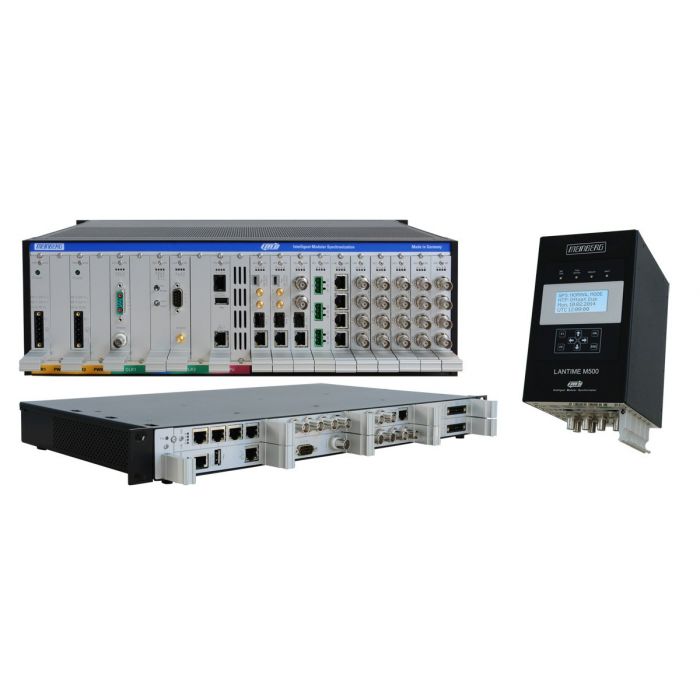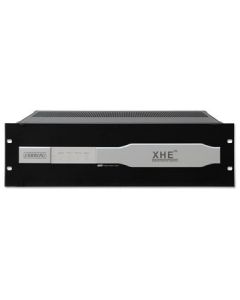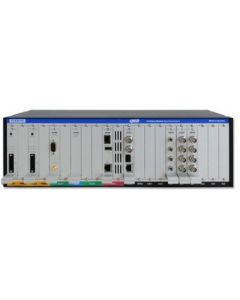
LANTIME PTP Grandmaster
LANTIME PTP Grandmaster
Meinberg
Modular IEEE 1588 Grandmaster and NTP Server with integrated satellite receiver
As an ultra stable NTP and PTP time provider, a LANTIME Grandmaster not only represents a highly accurate source of Synchronisation for all network devices supporting the Precision Time Protocol (PTP), the Network Time Protocol (NTP) and the Simple Network Time Protocol (SNTP), it also offers a number of legacy time and frequency outputs for keeping non-networked devices in sync.
Contact us for Lead Time
Click below to request a quote for this item. Or for product advice, stock and lead time enquiries call our team on 0330 313 3220.
| Attribute | Value |
|---|---|
| Manual URL | https://www.meinbergglobal.com/download/docs/manuals/english/ltos_6-24.pdf |
| Technical Support | Meinberg offers free lifetime technical support via telephone or e-mail. |
| Power Consumption | 50W (max. 100W) |
| Form Factor | Modular rackmount 3U chassis for standard 19'' racks 483 mm x 132 mm x 270 mm (W x H x D) |
| Relative Humidity | Max. 85% |
| Further information |
The PTP V2 (Multicast/Unicast) implementation is fully compliant to the IEEE 1588-2008 standard and provides PTP management messages as well. The PTP unit is able to Synchronise one step clocks and two-step clocks in master mode. In slave mode, the all PTP units can handle both one-step clock and two-step clock Synchronisation messages.
MRS Capability The Meinberg MRS technology (Multi Reference Sources) enables you to utilize one or more time and frequency references in prioritized order defined by your individual requirements. The Meinberg Intelligent Reference Switching Algorithm (IRSA) ensures that switching from a highly accurate reference source (e.g. GPS) to a less accurate one (e.g. IRIG or NTP) is delayed as long as the internal ultra stable oscillator is capable of maintaining an accuracy level that is better than the one of the next available reference source in the priority list. Redundancy of reference time sources The MRS technology offers a flexible solution to the changing availability of different Synchronisation sources for highly critical operating systems. The ability to use multiple independent sync references allows you to fulfil redundancy requirements of your network Synchronisation solution. Lab environments Monitoring and measurement of Synchronisation sources such as determining and logging the accuracy of an IRIG generator or a PPS source is easily done with the MRS functionality. Furthermore, LANTIME PTP Grandmaster systems are a perfect solution to test the PTP Synchronisation quality within existing network environments by automatically comparing the PTP input source to another high accurate reference source like GPS or 1PPS. All reference inputs can be measured against each other. PTPv2 Translator The MRS system allows you to translate PTP into a variety of output signals like 1PPS, 10MHz or IRIG. This feature makes it easy to transfer legacy timing signals over a IP based infrastructure while maintaining very high accuracy. All LANTIME IEEE 1588 Grandmaster are equipped with high precision oscillator "OCXO HQ" (look at oscillator options for details) as standard. The oscillator determines the holdover characteristics (e.g. when the GNSS signal is disturbed or jammed). The oscillator option "OCXO DHQ" is available to fulfil higher requirements. Meinberg PTP Grandmaster for different Industries Broadcast: IEEE 1588 PTPv2 is the selected technology for synchronizing studio equipment over IP. A live networked infrastructure environment with COTS switch equipment and live networked video devices has already been presented to the public in experimental case studies. Today it is already agreed that IEEE 1588 (PTP) will be the basis for synchronizing all clocks in a TV or radio studio. For the Audio-over-IP world, technologies like AES67 or RAVENNA already use PTP as their choice for time Synchronisation. Power and Industrial Automation: A LANTIME PTP Grandmaster provides a collection of Synchronisation outputs for various devices such as IEDs and SCADA systems: IEEE 1588 Grandmaster Clock (Multi-Profile, incl. IEEE 1588-2008, IEEE C37.238-2011, C37.238-2017 IEC 61588, IEC 61850-9-3, IEC 62439-3 Annex B and IEEE 802.1AS TSN/AVB) IRIG- and AFNOR time codes (DCLS and AM) In/Out (S)NTP time server with HW time stamping Telecom Networks: All Meinberg LANTIME systems have been designed to fulfil the Synchronisation requirements of modern 4G/LTE networks. The PTP implementation support both ITU-T profiles, ITU-T G.8265.1 for frequency and ITU-T G.8275.1 / G.8275.2 for frequency and phase. This allows to provide accurate frequency and phase Synchronisation over packet networks to all network elements requiring Synchronisation, including 2G/3G/4G base stations as well as LTE advanced networks. Obtaining Traceability in the Financial Sector: Meinberg's LANTIME PTP Grandmaster have been designed to fulfil the emerging time-stamping requirements of the financial sector. For systems with a gateway latency of less than 1 millisecond, the MiFID II directives require a timestamp accuracy of better than 100 microseconds as described in RTS 25, the Regulatory Technical Standards. |
| Reference Options |
|
| Frequency Outputs | Accuracy depends on oscillator (standard: OCXO-SQ) |
| Accuracy of Pulse Outputs | < ±50ns (OCXO SQ, OCXO MQ, OCXO HQ, OCXO DHQ) |
| Universal Serial Bus (USB) Ports |
1x USB Port in front panel:
- install firmware upgrades - backup and restore configuration files - copy security keys - lock/unlock front keys |
| CPU |
AMD Geode™ LX 800 (500 MHz, 128 KB L2 cache, 3.6 W)
Main Memory: onboard 256 MByte Flashdisk: 1 GB |
| Operating System of the SBC | GNU/Linux 4.x |
| Network protocols OSI Layer 4 (transport layer) | TCP, UDP |
| Network protocols OSI Layer 7 (application layer) | TELNET, FTP, SSH (incl. SFTP, SCP), HTTP, HTTPS, SYSLOG, SNMP |
| Internet Protocol (IP) | IP v4, IP v6 |
| Network Autoconfiguration Support |
|
| Network Time Protocol (NTP) |
NTP v2 (RFC 1119), NTP v3 (RFC 1305), NTP v4 (RFC 5905) SNTP v3 (RFC 1769), SNTP v4 (RFC 4330) MD5 / SHA-1 Authentication and Autokey Key Management |
| Parallel Redundancy Protocol (PRP) | PRP (IEC 62439-3) |
| Time Protocol (TIME) | Time Protocol (RFC 868) |
| Daytime Protocol (DAYTIME) | Daytime Protocol (RFC 867) |
| IEC 61850 | Synchronisation of IEC 61850 compliant devices by using SNTP |
| Hypertext Transfer Protocol (HTTP) | HTTP/HTTPS (RC 2616) |
| Secure Shell (SSH) | SSH v1.3, SSH v1.5, SSH v2 (OpenSSH) |
| Telnet | Telnet (RFC 854-RFC 861) |
| Simple Network Management Protocol (SNMP) | SNMPv1 (RFC 1157), SNMPv2c (RFC 1901-1908), SNMP v3 (RFC 3411-3418) |
| Scope of supply | Product documentation and software on USB storage device. |
| Firmware Updates | Firmware is field-upgradeable, updates can be installed directly at the unit or via a remote network connection. Software updates are provided free of charge, for the lifetime of your Meinberg product. |
| WEEE status of the product | This product is handled as a B2B category product. In order to secure a WEEE compliant waste disposal it has to be returned to the manufacturer. Any transportation expenses for returning this product (at its end of life) have to be incurred by the end user, whereas Meinberg will bear the costs for the waste disposal itself. |
| Precision Time Protocol (IEEE 1588) |
PTP/ IEEE 1588-2008 including
Network Protocols: - UDP/IPv4 (Layer 3) (Multicast/Unicast) - IEEE 802.3 (Layer 2) (Multicast) Delay Mechanisms: - End-to-End (Multicast/Unicast) - Peer-to-Peer (Multicast) PTP Management Messages for monitoring and configuration |
| RoHS | Yes |
| Key Features |
|
| Operating Temperature | 0 ... 50°C / 32 ... 122°F |
| Power Supply | Maximum power range: AD10: 90-265 V AC, 47-63 Hz / 90-250 V DC DC20: 20–60 V DC DC10: 10–36 V DC Redundant power supplies available |
| Attribute | Value |
|---|---|
| Data Sheet | Click here to view |





